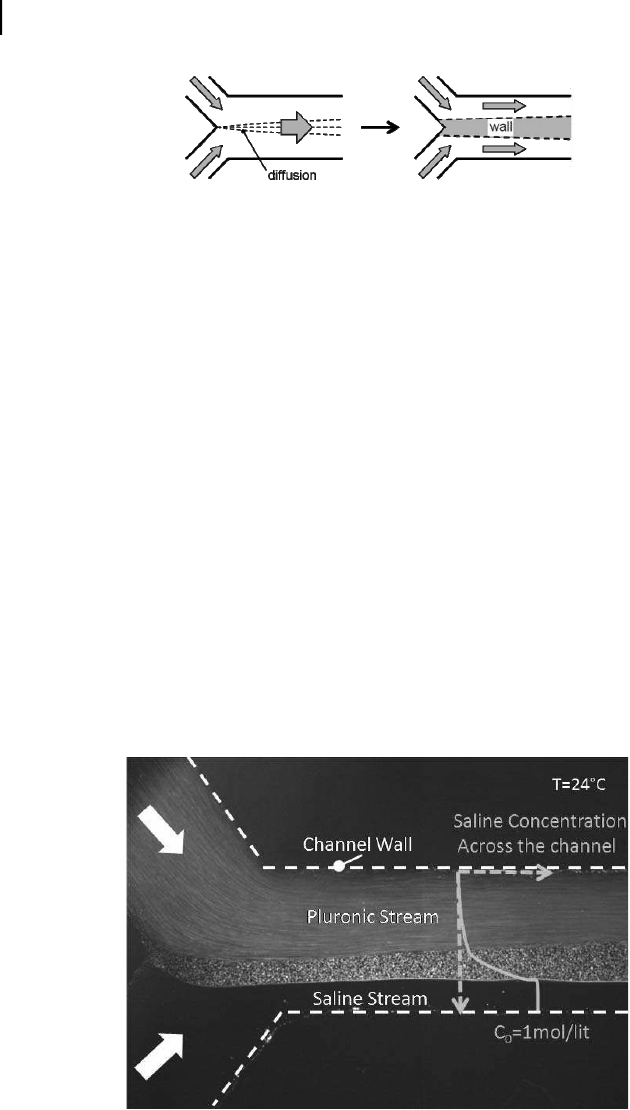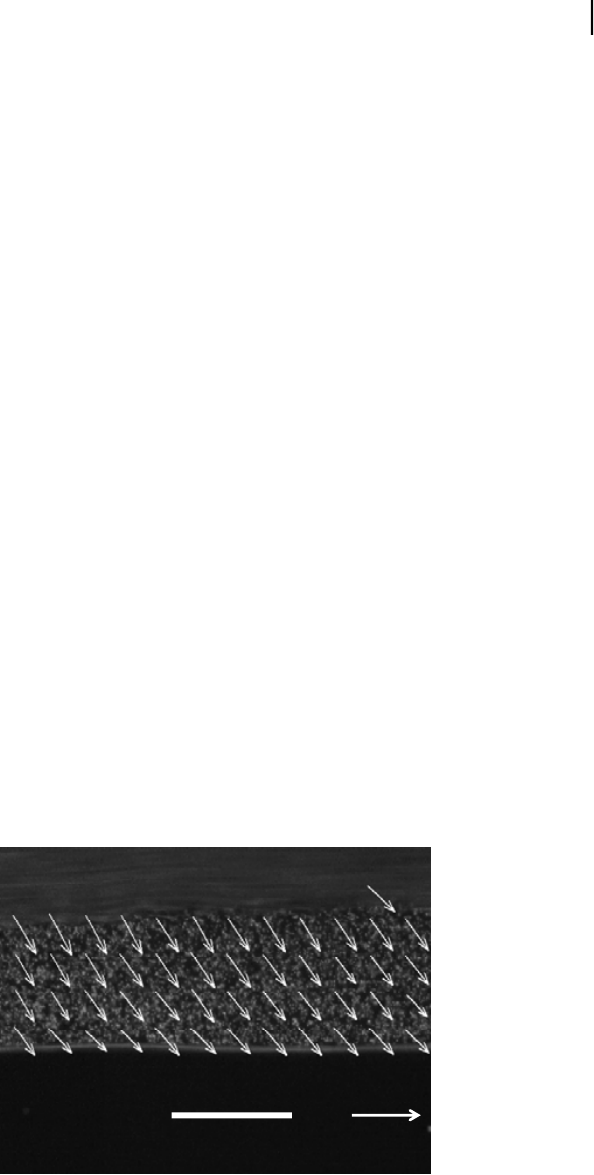
132 V. Bazargan and B. Stoeber
Figure 6.13. Concept of wall formation in a microfluidic channel at the diffusive interface
between two fluids.
6.5.3 Cross-Channel Transport
6.5.3.1 Concept of Cross-Channel Transport using a Gel Wall
Figure 6.13 shows the concept of formation of a wall between two fluids in a
microfluidic channel. Diffusion of compounds occurs across the interface between
both fluids. Presence of one compound in the other stream leads to formation of
a wall in the center of the channel. If further the material system and the flow
condition are chosen appropriately, this wall can be removed on one side and
regenerated on the other side at a constant rate leading to a steady displacement of
the wall perpendicular to the flow velocity of the fluid. During wall generation, if
objects such as compounds, particles or cells are incorporated into the wall, these
objects are slowly moved from one fluid stream into the other stream.
6.5.3.2 Generation of a Gel W all in a Microchannel
Figure 6.14 shows a microfluidic device with two inlet channels, one for a Pluronic
F127 solution and one for a saline solution. The channels were fabricated in
Figure 6.14. Top view of a microfluidic device. Pluronic solution and saline solution are
introduced in a 10 μm high microchannel at T
a
=24
◦
C. Gel formation occurs in the center of
the channel. The Pluronic stream is seeded with fluorescent particles. For color reference,
see page 268.
SO13997_text.indd 140SO13997_text.indd 140 26/01/2011 3:50 PM26/01/2011 3:50 PM

Flow Control in Biomedical Microdevices using Thermally Responsive Fluids 133
polydimethylsiloxane (PDMS) using standard soft lithography techniques; then
the PDMS was bonded to a glass substrate.
The 15 wt% Pluronic solution has a gel temperature of 26.5
◦
C, which is above
the ambient temperature T
a
=24
◦
C. A gel wall forms in the center of the channel
where sodium phosphate from the saline stream diffuses into the Pluronic stream.
This leads to a locally reduced gel formation temperature for the Pluronic solution
according to the phase diagram in Fig. 6.4. Fig. 6.14 also shows the distribution of
sodium phosphate ions across the channel. The ions diffuse from the saline stream
across the gel wall into the Pluronic solution. The ion concentration in the wall
near the Pluronic stream is the minimum concentration at which gel formation can
occur at ambient temperature. The concentration inside the wall near the saline
stream corresponds to the critical sodium phosphate concentration above which
gel formation cannot occur. At steady state, sodium phosphate diffuses from the
saline stream into the Pluronic stream at a constant flux. This increases the sodium
phosphate concentration in the wall near the saline stream above the critical
concentration and therefore the saline side of the wall liquefies. At the same time,
the steady diffusion of ions into the Pluronic stream increases the ion concentration
in this stream near the wall above the necessary concentration for gel formation
at ambient temperature T
a
= 24
◦
C. As a consequence, the wall is permanently
removed near the saline solution, while it is simultaneously rebuilt in the Pluronic
stream. This leads to a steady motion of the wall across the microchannel, as
documented through the PIV measurement in Fig. 6.15. The cross-channel velocity
of the wall is nearly constant at v =5μm/s, and it is insensitive to the magnitude
of the pressure driving the fluids and the concentration of the saline solution. This
suggests that the motion of the wall is defined by the gel removal rate near the
saline solution.
Figure 6.16 shows the wall thickness along the flow channel for different
experimental conditions. In all cases, the wall thickness increases almost linearly
ϭϬ
ϱ
ŵͬƐ
ϭϬϬђŵ
WůƵƌŽŶŝĐ^ŽůƵƚŝŽŶ
^ĂůŝŶĞ^ŽůƵƚŝŽŶ
Figure 6.15. Velocity field of a section of the wall from PIV.
SO13997_text.indd 141SO13997_text.indd 141 26/01/2011 3:50 PM26/01/2011 3:50 PM
Get Biomaterials for MEMS now with the O’Reilly learning platform.
O’Reilly members experience books, live events, courses curated by job role, and more from O’Reilly and nearly 200 top publishers.

